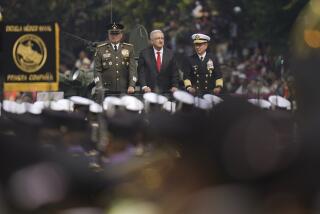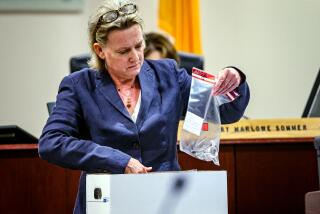Consulate Wants Probe Reopened in Shooting of Mexican Bandit
Mexican Consul General Javier Escobar on Thursday filed a formal request with Dist. Atty. Edwin Miller to investigate the May 4 death of a Mexican border bandit in a police shoot-out.
“Based on the findings of the autopsy done in Tijuana, we are asking Mr. Miller to reopen the investigation into the shooting of a Mexican national,” said Escobar. “According to the autopsy report, the shooting occurred at point-blank range.”
The findings of the autopsy, which was performed last week on the man’s exhumed body by Tijuana coroner Dr. Gustavo Salazar, conflicted with an autopsy report by the San Diego County coroner’s office. An autopsy conducted May 6 by county pathologist Dr. David M. Katsuyama supported a police report that said the fatal shot was fired from a distance of 30 to 40 feet.
Steve Casey, a district attorney’s office spokesman, said that Miller received Escobar’s letter late in the afternoon. Casey said prosecutors will study the consulate request and probably issue a reply next week.
According to the police report, Julio Arroyo Zaragoza was fatally shot in the head during a nighttime gun battle with members of the Border Crimes Prevention Unit, comprised of San Diego police and Border Patrol agents. Arroyo, 33, died from a 9-millimeter bullet that struck him in the middle of the forehead, at the hairline.
Police said that Arroyo, his brother, Jaime Arroyo Zaragoza, and an unidentified third suspect were robbing illegal aliens in the border canyons when they were confronted by the border unit. Jaime Arroyo, 23, who was not hurt in the incident, was apprehended and later charged with robbery and attempted murder. The third suspect escaped. An agent was shot five times by Julio Arroyo, but was saved by an armored vest and is back on duty.
Jaime Arroyo has told family members and his attorney that police killed his brother after he was wounded and disarmed. Attorney Jose Tafolla, who is representing Jaime Arroyo and Julio Arroyo’s widow and mother, said Thursday that he is pleased by Escobar’s request for a new investigation.
“Obviously, his request will carry a lot of weight, but my plan is still to submit a request of my own to have the investigation reopened,” said Tafolla. Last week Tafolla said that he plans to ask the county and federal grand juries and the state attorney general’s office to investigate police conduct on the night of the incident.
Meanwhile, Tafolla said he plans to meet with San Diego County Coroner David J. Stark today to examine new evidence that both sides have uncovered in the controversial case.
Dr. Hormez Guard, a former county pathologist who is a critic of the coroner’s office, said that laboratory tests done in San Diego on tissue samples of Arroyo’s skin and skull show traces of gunpowder. The samples were taken during the Tijuana autopsy, and Guard, who was hired by Tafolla, said the gunpowder shows that Arroyo was shot at point-blank range. The laboratory tests support Salazar’s findings, said Guard.
Last week, San Diego Police Chief William Kolender and Stark questioned Salazar’s competence and the integrity of the autopsy he performed in Tijuana. But in a June, 1979, letter, Miller praised Salazar for his “superior professional performance” and quoted a judge as saying that Salazar was “the finest forensic pathologist he had ever heard testify.”
Salazar testified in the murder trial of Ronnie Lee Beverly, who was sentenced to life in prison for the murder of Jo Ann Asakawa. Asakawa’s body was found near Tijuana, and Salazar performed the initial autopsy.
On Wednesday, Stark announced that tests performed this week by his office on tissue samples from Arroyo’s brain showed no traces of gunpowder. Stark said his office found the samples last week, and that the tests support the police version that Arroyo was shot by Officer Cesar Solis from a distance and not from close range.
In June, Katsuyama told The Times that he saw no evidence that Arroyo died from a contact wound, a wound suffered when a gun barrel is placed on the skin or very near to it. Katsuyama said that he did not save tissue samples from around the wound, and Stark later admitted that Katsuyama failed to perform the necessary laboratory tests of the fatal wound.
In an interview on June 26, Katsuyama said the fatal bullet entered Arroyo’s head at a 90 degree angle. However, pictures taken of the Tijuana autopsy show the bullet entering at a downward angle, shattering the top of the skull and the base in three places. Katsuyama’s autopsy report said the bullet was recovered under the man’s left jaw.
Thursday’s request by Escobar for an investigation marks the second time in five months that he has asked Miller to investigate a border shooting in which a Mexican citizen was killed or injured. In April, Escobar asked Miller to investigate Border Patrol Agent Edward (Ned) Cole for his role in the wounding of a 12-year-old Mexican boy.
The youth, Humberto Carrillo Estrada, was standing on the Mexican side of the border fence when Cole fired three rounds from his .357 magnum through the fence. The boy was struck once in the back and recovered after he was hospitalized at a San Diego hospital. Miller decided not to prosecute Cole, who had been cleared in a Border Patrol investigation of the shooting.
Cole said he fired at the youth in self-defense after Humberto and another youth allegedly began pelting rocks the size of “small boulders” over the nine-foot fence at agents who were arresting Humberto’s brother for illegal entry. The brother was returning to Mexico through a hole in the fence after eating at a San Ysidro fast-food restaurant.
More to Read
Sign up for Essential California
The most important California stories and recommendations in your inbox every morning.
You may occasionally receive promotional content from the Los Angeles Times.










